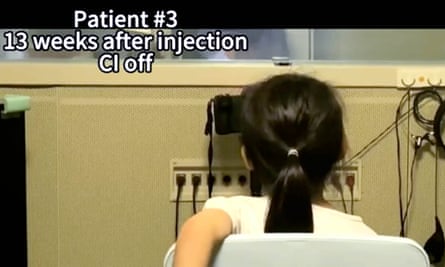Five children who were born deaf now have hearing in both ears after taking part in an “astounding” gene therapy trial that raises hopes for further treatments.
The children were unable to hear because of inherited genetic mutations that disrupt the body’s ability to make a protein needed to ensure auditory signals pass seamlessly from the ear to the brain.
Doctors at Fudan University in Shanghai treated the children, aged between one and 11, in both ears in the hope they would gain sufficient 3D hearing to take part in conversations and work out which direction sounds were coming from.
Within weeks of receiving the therapy, the children had gained hearing, could locate the sources of sounds, and recognised speech in noisy environments. Two of the children were recorded dancing to music, the researchers reported in Nature Medicine.

Dr Zheng-Yi Chen, a scientist at Massachusetts Eye and Ear, a Harvard teaching hospital in Boston that co-led the trial, said the results were “astounding”, adding that researchers continued to see the children’s hearing ability “dramatically progress”.
The therapy uses an inactive virus to smuggle working copies of the affected gene, Otof, into the inner ear. Once inside, cells in the ear use the new genetic material as a template to churn out working copies of the crucial protein, otoferlin.
Video footage of the patients shows a two-year-old boy responding to his name three weeks after the treatment and dancing to music after 13 weeks, having shown no response to either before receiving the injections.
Another patient, a three-year-old girl, fails to react to sounds, but 13 weeks after the treatment can understand sentences and speak some words.
The oldest patient, an 11-year-old girl, showed no response to tones played at various pitches before the therapy, but reacted to all of them six weeks later and was able to take part in speech training from the 13-week mark.
More than 430 million people globally are affected by disabling hearing loss, of which about 26 million are deaf from birth.
Up to 60% of childhood deafness is due to genetic factors. The children in the trial have a condition called DFNB9, caused by Otof mutations, which accounts for 2-8% of all congenital hearing loss.
after newsletter promotion
In January, the same US-Chinese team reported improvements after treating the deaf children in one ear, but the intention was always to give hearing in both ears. If they can hear in both ears, the children can work out where sounds are coming from, a capability important for everyday situations such as talking in groups and being aware of traffic when crossing the road, the researchers said.
It will take larger trials to assess the benefits and risks of the therapy in more detail. The gene therapy is injected during a minimally invasive surgical procedure, so treating both ears doubles the time that patients spend in surgery. Treating both ears also raises the risk of a stronger immune reaction, triggered when the body’s defences react to the virus that delivers the therapy.
“Our hope is this trial can expand and this approach can also be looked at for deafness caused by other genes or non-genetic causes,” Chen said. “Our ultimate goal is to help people regain hearing no matter how their hearing loss was caused.”
Last month, a British toddler became the first person to have her hearing restored in one ear after receiving a similar gene therapy for hearing loss caused by Otof mutations.
Prof Manohar Bance, the chief investigator on that trial, said the therapy marked a new era in the treatment of deafness.
Source: theguardian.com


